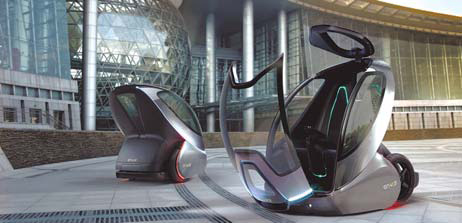

More than half of the world's population currently lives in cities. In 20 years, another 10 percent are expected to become urban residents.
|
 |
|
The EN-V is designed to alleviate problems with traffi c congestion, parking, air quality and aff ordability in tomorrow’s cities. |
By then metropolises around the world will be home to 5 billion people. This growing urbanization is creating a major challenge for public infrastructure already under enormous pressure to keep up with growing demand for transportation.
With a shared vision of addressing the need for personal mobility through a revolutionary change in personal urban transportation, General Motors and its strategic partner, SAIC are exploring solutions for tomorrow.
Among the most promising is a GM concept called Electrical Networked-Vehicle - or EN-V - a solution for future personal urban transportation provided by GM.
| |||
It is a centerpiece of the SAIC-GM Pavilion at the World Expo in Shanghai, which officially opens today and will continue through the end of October.
"EN-V reinvents the automobile by creating a new vehicle DNA through the convergence of electrification and connectivity," said Kevin Wale, president and managing director of the GM China Group.
"It provides an ideal solution for urban mobility that will enable future driving to be free from petroleum and emissions, free from congestion and accidents, and more fun and fashionable than ever before."
Breakthrough technology
The EN-V's platform evolved from the Personal Urban Mobility and Accessibility (PUMA) prototype that developed by Segway in cooperation with GM, which made its debut in April 2009.
Powered by pollution-free lithium-ion batteries, the EN-V can be recharged from a conventional wall outlet using standard household power, allowing the car to travel up to 40 km on a single charge.
The EN-V can also improve the efficiency of public electric infrastructure since the vehicle can communicate with the electric grid to determine the best time to recharge based on overall usage.
By combining GPS with vehicle-to-vehicle communications and distance-sensing technologies, the vehicle can be driven both manually and autonomously.
The combination of sensing technology, wireless communication and GPS-based navigation establishes a technology foundation that could lead the way to future advanced vehicle safety systems.
Its autonomous operating capability offers the promise of reducing traffic congestion by allowing EN-V to automatically select the fastest route based on real-time traffic information.
The concept also leverages wireless communications to enable a "social network" that can be used by drivers and occupants to communicate with friends or business associates while on the go.
The ability to "talk" to other vehicles could dramatically reduce the number of vehicle accidents.
Using vehicle-based sensor and camera systems, the EN-V can sense its surroundings, allowing the vehicle to react quickly to obstacles or changes in driving conditions.
It could also offer mobility to those who could not otherwise operate a vehicle, such as the elderly and handicapped.
"EN-V represents a major breakthrough in the research that GM has been doing to bring vehicle autonomy to life," said Alan Taub, global vice president of GM Research and Development.
"The building blocks that enable the autonomous capabilities such as lane departure warning, blind zone detection and adaptive cruise control are being used in some GM vehicles on the road today."
The EN-V is specially designed for the speed and range of today's urban drivers. It weighs less than 500 kg and is about 1.5 m long, much lighter and smaller than today's typical automobile, which generally weigh more than 1,500 kg and are three times as long as EN-V.
Today's automobiles are parked more than 90 percent of the time and on average require more than 10 sq m of parking space. That same space can accommodate five EN-Vs.
Smaller, smarter design
GM capitalized on its worldwide design resources for the designs of the three concept car models, with miao - magic - coming from the GM Advanced Design Studio in California, jiao - pride - penned by designers at GM Europe and xiao - laugh - designed by GM Holden's design team in Australia.
Each EN-V has a unique design theme to showcase the flexibility of its propulsion platform. miao takes most of its design cues from the consumer electronics industry, as evidenced by its sleek, masculine looks.
Designers also used miao to display innovative lighting solutions, including extensive use of LED accent lighting.
With its clean lines and bright paintwork, jiao takes its design influence from bullet trains and Chinese opera masks. Xiao offers a more lighthearted appeal, with its "gumball blue" paint and nautical-inspired design.
"The future of how we move around in urban areas like Shanghai can combine the best of personal mobility and public transit. EN-V demonstrates that we have both the knowledge and the ability right now to create a way to move people that not only ensures a 'better city' but also offers people a 'better life,'" said Taub.
(China Daily 05/01/2010 page3)
